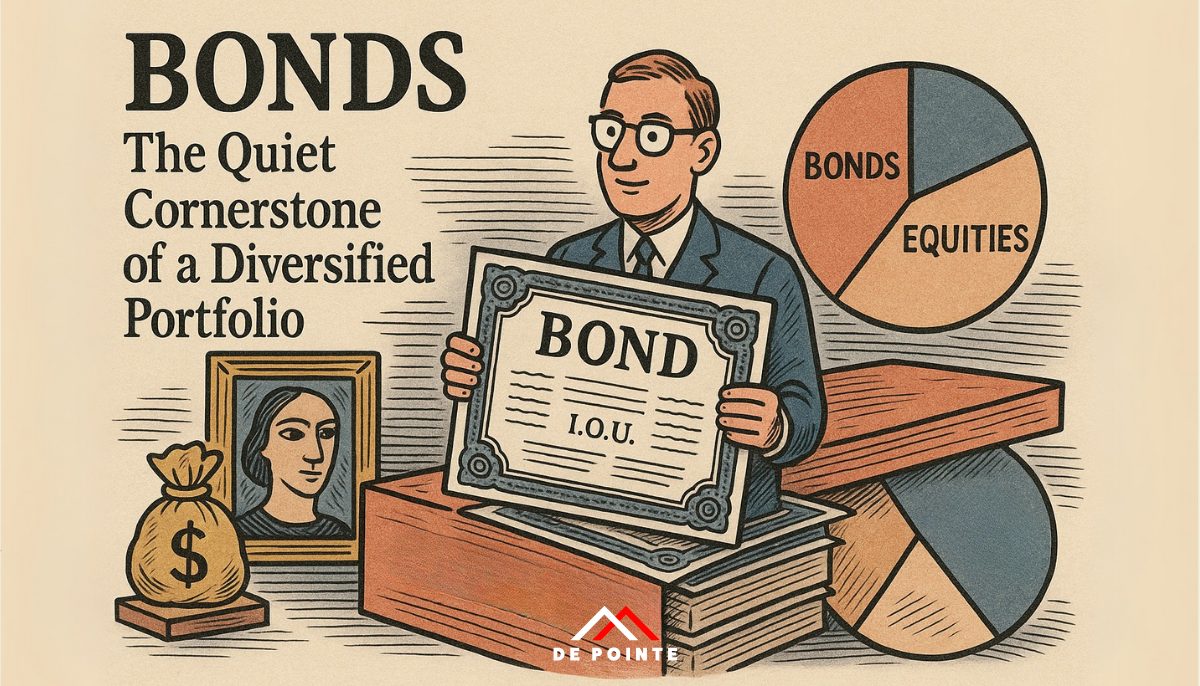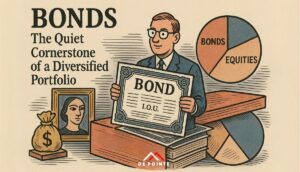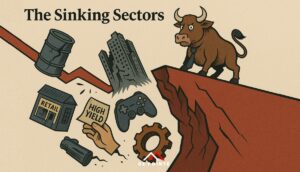Article

In an investment landscape dominated by headlines about cryptocurrency swings, AI-driven equities, and luxury collectables, it’s easy to forget the quiet, steadfast performer in many portfolios: bonds. While they may lack the glamour of a Banksy or the allure of bullion, bonds offer something increasingly scarce in today’s economy—predictability.
At De Pointe Research, we believe every portfolio needs an anchor. For many of our clients, that anchor takes the form of tangible alternative assets like art, gold, or real assets. But whether you’re allocating into fine art or fractionalised whisky barrels, a robust understanding of bonds and their role in modern portfolio construction is essential.
What Exactly Is a Bond?
A bond is essentially a loan you make to a borrower—typically a government or corporation. In return, the borrower agrees to pay you periodic interest (the “coupon”) and return the full principal on a specified date (the “maturity”).
They’re often described as “fixed-income” investments because they typically offer consistent returns over a fixed timeline—something that can be especially valuable during turbulent market periods.
There are four main types of bonds worth understanding:
- Government Bonds
- In the UK, these are referred to as gilts. Backed by the government, they’re considered low-risk and are often used as a benchmark for the broader bond market.
- Corporate Bonds
- Issued by companies seeking capital. Risk and return can vary greatly depending on the creditworthiness of the issuer.
- Municipal Bonds
- Common in the U.S., these are issued by local governments and often offer tax advantages. While less relevant to UK investors, they’re worth watching for diversification.
- Green Bonds
- Designed to fund sustainable projects, green bonds are increasingly popular among ESG-focused investors.
Bonds vs. Equities vs. Alternatives
We’re often asked, “If I already hold alternative assets like art or gold, do I really need bonds?” Our answer: absolutely—if not more so.
Here’s why:
- Income: Bonds provide a reliable, predictable stream of income. Most alternatives—particularly art and collectables—are capital-gain-focused and illiquid. Bonds, meanwhile, pay regularly and mature on schedule.
- Risk Hedging: When stock markets falter, or geopolitical uncertainty rises, quality bonds tend to appreciate. They offer a natural hedge, particularly during economic downturns.
- Liquidity: Unlike private equity or art funds, many bonds can be sold quickly on secondary markets, giving investors optionality without the typical exit challenges associated with illiquid alternatives.
- Capital Preservation: Certain bonds, particularly short-duration government gilts, are ideal for preserving capital while still generating a modest return.
The Current State of Bonds (2025)
After two years of sharp interest rate hikes from central banks trying to tame inflation, the global bond market is experiencing something of a revival. Yields are attractive, inflation is trending down, and the era of zero or negative rates feels firmly in the rear-view mirror.
Key trends we’re watching:
- UK Gilts are yielding well above inflation for the first time in years, and index-linked gilts are back in favour of investors wary of long-term inflation risk.
- High-grade corporate bonds offer yields of 5–7%, providing real income opportunities without excessive risk.
- Global diversification is back on the agenda. Bonds in emerging markets and Asia are offering significant spreads, albeit with currency and political risk.
- Short-duration bonds are increasingly popular among cautious investors looking to reinvest opportunistically as interest rates evolve.
Portfolio Positioning: Where Bonds Belong
At De Pointe, we advocate a diversified, intelligent asset allocation approach—anchored by real assets, protected by income, and responsive to macroeconomic shifts.
A sample allocation model for a high-net-worth investor might look like:
- 20% in tangible alternatives – including art, gold, and collectables
- 30–40% in equities – focused on long-term capital appreciation
- 25–35% in bonds – balancing income, liquidity, and defensive characteristics
- 5–10% in cash equivalents – for flexibility and opportunism
Bonds are not exciting. But they don’t need to be. They’re the ballast in a vessel that lets you sail further and faster elsewhere. When structured correctly, a bond portfolio can enhance returns, reduce volatility, and provide a strategic foundation from which to pursue higher-yielding alternatives.
A Bond’s Role in an Alternative Strategy
For many of our clients, art and gold serve as protection against inflation, fiat currency devaluation, and geopolitical chaos. However, we often see one missing piece in these portfolios: a core income stream that keeps capital working during long holding periods.
For example:
- A bond ladder (staggered maturities) can provide predictable inflows to fund new art acquisitions.
- Bonds can stabilise overall portfolio volatility, offsetting the mark-to-market sensitivity of luxury goods or niche real estate.
- Most importantly, bond yield reinvestment allows compounding to work its magic—something even the most valuable artworks can’t deliver until they’re sold.
At De Pointe Research, we aim to help investors build portfolios that perform under pressure and endure over decades. While we’re passionate advocates of the alternative investment world, we know success is built on balance. Bonds offer just that—steady, understated, and often underappreciated.
Whether you’re rebalancing a traditional portfolio or structuring an income-friendly, tax-efficient alternative investment strategy, don’t underestimate the role of fixed income.
In a rapidly changing world, the quiet certainty of a bond can provide clarity—and cash flow—when it’s needed most.





